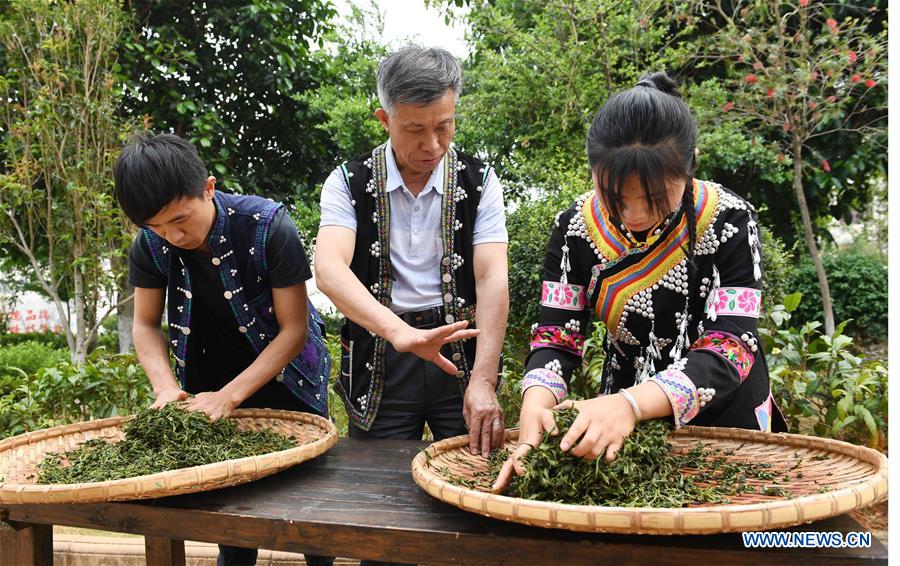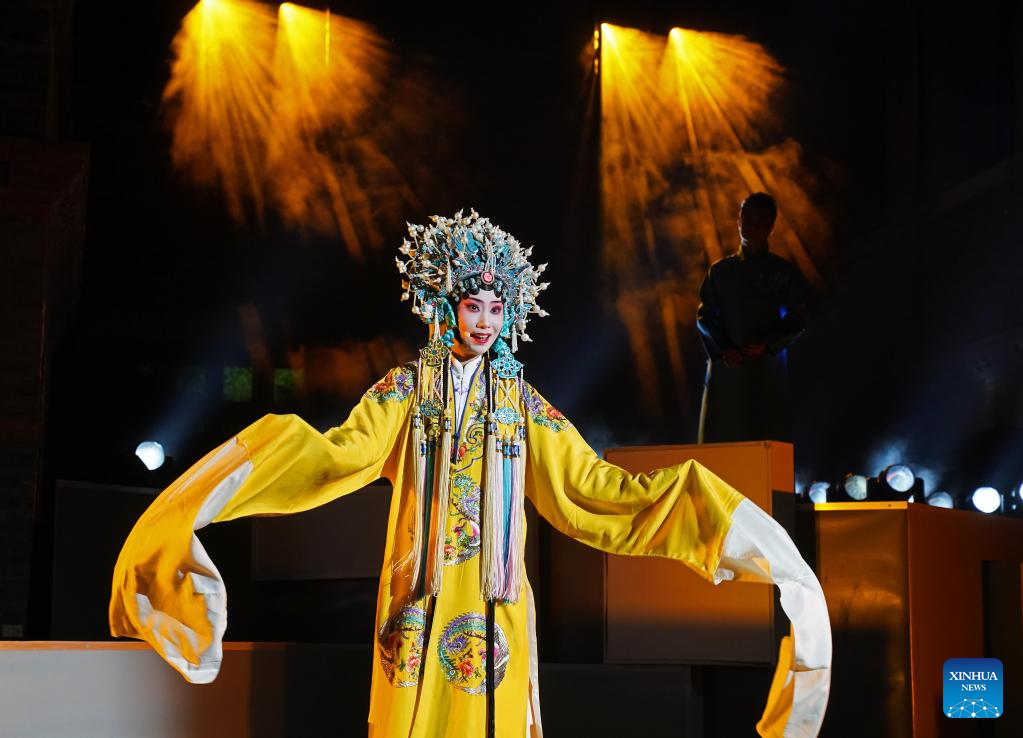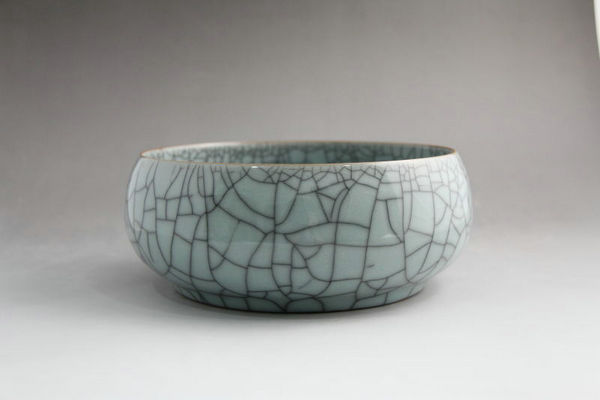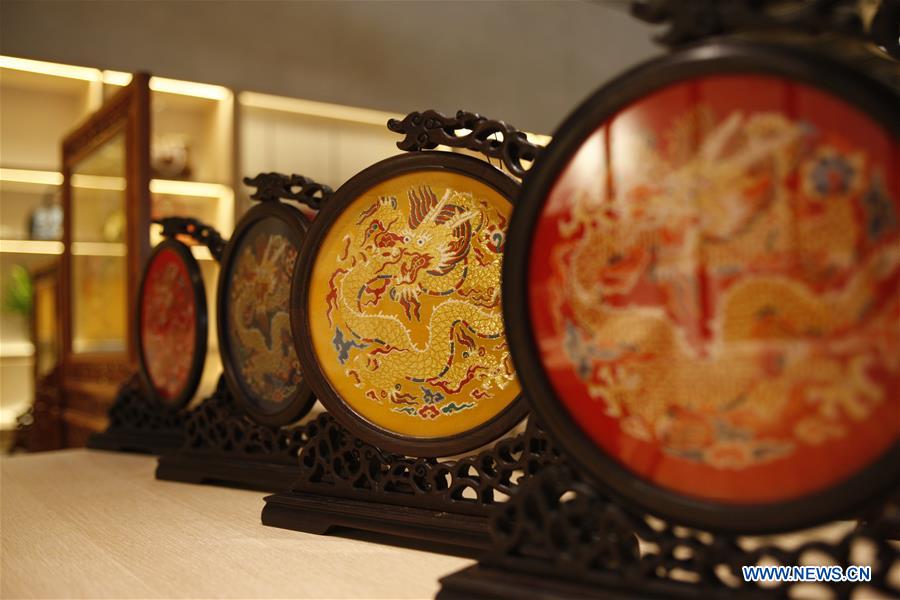Inheritors share stories of global recognition of China's intangible cultural heritages
From:People's Daily OnlineAuthor: 2025-01-09 11:11

Li Xingchang (C), an inheritor of the making technique of famous Chinese Pu'er tea, teaches apprentices how to knead tea leaves at a Pu'er tea promotion base in Ning'er Hani and Yi Autonomous County of Pu'er City, southwest China's Yunnan Province. (Photo/Xinhua)
Recently, the United Nations Educational, Scientific, and Cultural Organization (UNESCO) inscribed the Spring Festival, the social practices of the Chinese people in celebration of the traditional new year, on the Representative List of the Intangible Cultural Heritage (ICH) of Humanity, bringing the number of ICH items in China on the UNESCO list to 44.
These ICHs embody the skills and practices of the Chinese people for thousands of years, becoming globally recognized symbols of Chinese culture.
The key to the protection and inheritance of ICHs lies in the people. With its rich variety, how can intangible cultural heritage stay vibrant over time? How can these shining symbols be used to better tell the Chinese story? Here's what the inheritors of ICHs have to say.
The aroma of Pu'er tea spreads around the world
Li Xingchang is a provincial-level inheritor of the techniques for making gongcha, or Pu'er "tribute tea", in Ning'er Hani and Yi Autonomous County, Pu'er city, southwest China's Yunnan Province. The production techniques of Pu'er tea were included in the item "traditional tea processing techniques and associated social practices in China", which was added to the UNESCO list.
The production techniques of Pu'er tea, which involve complex steps like picking tea leaves, withering, fixation and rolling, reflect the relentless pursuit and dedication of tea craftsmen.
Li established a workshop aimed at passing on the production techniques of Pu'er tea, offering courses according to the tea-growing cycle. In winter, courses instruct students on how to loosen the soil and prune the branches; in spring, courses focus on the production techniques and brewing skills.
Chinese tea culture has spread across the world and gained greater influence. Once, a foreign student upon learning that Li's workshop offered tea-making courses, came all the way to Pu'er city. After the student made his ow tea cake, he exclaimed, "I never imagined that such a simple leaf could become such a delicious drink through these techniques!" The moment gave Li a great sense of achievement as a craftsman.
"What makes me happy is seeing an increasing number of young people are willing to learn traditional tea processing techniques. They are launching innovative tea drinks and holding activities to experience tea culture. This shows me that the torch is being passed on, and makes me feel the inheritance and innovation of tea culture in modern times," said Li.
Kunqu Opera thrives through mutual integration and appreciation

An artist performs on stage in Hongkou District, east China's Shanghai on April 14, 2023. The Inlet, a fashion landmark located in Hongkou District of Shanghai, staged a Kunqu Opera themed concert titled "Kunplug". (Xinhua/Liu Ying)
Kunqu Opera, originating in Kunshan, east China's Jiangsu Province, is one of the oldest existing Chinese dramatic forms. It developed from the Southern Opera at the end of the Yuan Dynasty (1271-1368) and early Ming Dynasty (1368-1644), combining local music, dance, and language.
Ke Jun is a provincial-level inheritor of Kunqu Opera, and after over 40 years of experience in the trade, he's looking at ways to allow it to continue to prosper in the modern era.
"Having engaged in the trade for over 40 years, I've always pondered how to drive the innovative development of Kunqu," he said.
Kunqu is gaining increasing international recognition. In 2016, Ke collaborated with British director Leon Rubin on a magnificently-crafted Kunqu production that brought the works of Shakespeare and his Chinese contemporary Tang Xianzu together.
In 2023, a play featuring the story of Liang Bolong, the author of the first play of Kunqu Opera, rehearsed by Ke, was staged in a special way at the Guimet National Museum of Asian Arts in France, creating an immersive experience that blended the museum's architecture with European Heritage Days. The performance impressed Jean-Michel Tobelem, an associate professor at University Paris 1 Panthéon-Sorbonne, who remarked, "It was a novel experience, breaking down the barriers between different cultures and between actors and the audience, allowing for a pure appreciation of the performance."
Ke believes that culture, as a common heritage of all mankind, carries our collective cultural memories. Standing at the present moment in history, we must not only "tell the stories" but also have the courage to "continue telling" them, ensuring Kunqu Opera thrives through mutual integration and appreciation in the global context, living on for generations.
Conveying the essence of China through porcelain
The art of Longquan celadon has a history of more than 1,700 years, featuring unique techniques in material selection, glaze preparation, shaping, and kiln temperature control. The finished products embody China's classical aesthetic.
Xu Chaoxing is a national-level inheritor of the traditional firing technology of Longquan, which is a part of the UNESCO ICH list. Xu began learning the craft at the age of 13. Working with other master craftsmen, he helped recover nearly lost glaze formulas for Longquan celadon.

Photo shows Geyao, or the elder brother ware. (Photo/Xinhua)
Xu innovatively produced a celadon porcelain work that blends the styles of "elder brother" celadon, which has a black finish with a crackle effect, and the "younger brother" variety that has a thick, lavender-grey and plum-green finish.
Longquan celadon has been widely recognized and appreciated worldwide. The French have long had a fondness for celadon, and the connection between Longquan celadon and France dates back to the 14th century when two fragments of Longquan celadon were found in the garden of the Pope's Palace in Avignon.
In 2024, during the 60th anniversary of China-France diplomatic relations, two of Xu's works were exhibited at the China Arts Exhibition in Paris. The pieces conveyed the subtle, natural Chinese aesthetic and were warmly praised by local audiences.
Xu explained that in order to take celadon to the world, it needs continuous innovation and a spiritual inheritance, so that the condensed Chinese story can be recognized by more people.
The art of paper-cutting tells China's stories
Yuxian paper-cutting, which was founded in Yuxian county, north China's Hebei Province, is China's only type of pointillist paper-cutting. Zhou Shuying, a national-level inheritor of Yuxian paper-cutting, learned the craft since childhood.
She mastered different paper-cutting styles and developed various techniques to make Yuxian paper-cutting more vivid.
She expanded into diverse themes, creating paper-cutting works incorporating elements like the Beijing 2022 Winter Olympics, folk customs, and dance art.
In recent years, Zhou has ventured into cross-industry collaborations, integrating paper-cutting art with product design and animation.
Zhou participated in the design of the logo for the Fourth World Conference on Women. She also organized exhibitions, engaged in cultural exchanges, and demonstrated how to make paper cuttings in countries like the United States, France, Germany, and Canada.
An Australian painter, captivated by the charm of the craft of paper-cutting, traveled all the way to Yuxian county to learn from Zhou. "These days, we often chat online and share our artistic views," Zhou said.
Tradition and fashion blend to create the beauty of Yun Brocade

Photo taken on Sept. 26, 2018 shows Yun brocade products at the Nanjing Yunjin Museum in Nanjing, capital of east China's Jiangsu Province. (Xinhua/Zhu Weixi)
Yun brocade, from Nanjing, east China's Jiangsu Province, is a traditional Chinese silk brocade. It is named for its dazzling colors resembling the clouds in the sky.
Zhou Shuangxi is a national-level inheritor of Yun brocade who has worked to bring the historical craft into the modern world.
At the 2024 Shanghai Import Expo and the Jinan Intangible Cultural Heritage Expo, the Nanjing Yun Brocade Institute's live broadcast team wore "Yun Brocade Hanfu" and "Yun Brocade Horse-Faced Skirts," both designed by Zhou and his apprentices in recent years. The pieces drew inspiration from ceremonial costume patterns and color schemes, which have been "recreated" for contemporary appeal.
However, the preservation of Yun Brocade's tradition and innovation does not end there. Traditionally, it would take up to two years to produce a single set of such garments. With advancements in technology, this ancient craftsmanship has evolved, as computers are now connected to jacquard devices, transforming the masters' experience into programmed instructions, significantly reducing labor time and cost.
Yun Brocade is also making waves on the world stage. As early as 2015, Yun Brocade was featured at the Paris Haute Couture Fashion Week, challenging the perception that it is confined to traditional clothing. Later, at the Milan Expo, a classic Western artwork, Mona Lisa, was recreated using Yun Brocade, becoming the highlight of the "Nanjing Week" opening event. This marked a fusion of tradition and fashion, as well as a blending of Eastern and Western cultures.
Edit:董丽娜
The copyright of the article and the picture belongs to the original author. If there is any infringement, please contact to delete it